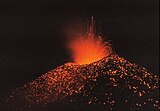Pelado Hill
| Pelado Hill | |
|---|---|
| Highest point | |
| Elevation | 680 metres (2,230 ft) |
| Coordinates | 10°22′08″N 85°00′51″W / 10.368853°N 85.014233°W |
| Naming | |
| Native name | Cerro Pelado Error {{native name checker}}: parameter value is malformed (help) |
| Geology | |
| Mountain type | Extinct volcano |
| Last eruption | Unknown |
Pelado Hill, from Spanish Cerro Pelado, also known as Pelado Peak, is an extinct volcano located 12 kilometres (7.5 mi) SE from Cañas (canton).[1][2]
Toponymy
Pelado translates to bare or naked, in this case, lack of forest canopy.
Physical aspects
Extinct for millions of years and highly eroded, the skeletal structure of the volcano caldera can still be appreciated. There is secondary activity nearby with hot springs and minerals. [2]
Social and economic activity
The hill is located in a private area made of eight properties and around 200 hectares (490 acres), tourism in the area boomed from 2007 onwards, as trails were built towards the peak of the hill and some rudimentary visitor facilities were built. Social networks such as Instagram and their influencers promoted the area due to the photogenic nature of the place. [3][4]
See also
References
- ^ Alvarado Induni, Guillermo. Los volcanes de Costa Rica. Editorial de la Universidad Estatal a Distancia. pp. 200–201. ISBN 978-9968-316-79-8.
- ^ a b "Volcanes de Costa Rica - Cerro Pelado". RSN UCR. Retrieved 11 April 2020.
- ^ Poltroneri, Marcelo (17 March 2018). "Cerro Pelado: el volcán de moda en Costa Rica". Retrieved 13 April 2020.
- ^ Rodríguez Valverde, Andrea (25 October 2017). "Cerro Pelado: An Ode to its Immensity". The Voice of Guanacaste. Retrieved 13 April 2020.


